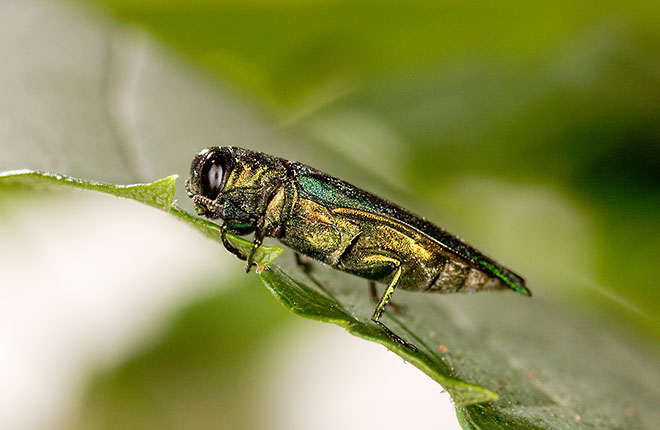Tiny Wasps May Rescue Ash Trees
Ash trees grow throughout the United States, offering shade, beauty, and animal habitat. The trees are also an important source of wood used to make furniture, musical instruments, tools, and baseball bats and other sports equipment.
Unfortunately, these valuable trees are threatened by the emerald ash borer (EAB). EAB is a nonnative forest pest from Asia that has killed hundreds of millions of ash trees in North America since its detection in 2002 in Detroit, Michigan, and Windsor, Ontario, Canada.
The cost of EAB damage is staggering. According to USDA Forest Service (FS) projections, the response to EAB infestation between 2009 and 2019 could cost up to $10.7 billion. This estimate includes treatment, removal, and replacement of more than 17 million ash trees.
Insecticides are one way to control invasive insect pest species over a limited area. Another solution—classical biological control—uses natural enemies that coevolved with a pest in its native range. When an insect species moves from its native range to a new area without native natural enemies, its population can explode.
Soon after EAB was detected in the United States, scientists from the Agricultural Research Service (ARS), FS, and the Animal and Plant Health Inspection Service (APHIS) began foreign exploration for EAB-specific natural enemies in EAB’s native range. In northeast China, they discovered three natural enemies—tiny parasitic wasps, or “parasitoids.” One of the wasps, Oobius agrili, attacks EAB eggs. The other two, Tetrastichus planipennisi and Spathius agrili, parasitize EAB larvae.
Classical biological control of EAB began in the United States in 2007, after APHIS approved release of these three species of parasitic wasps. These wasps have since been released in 22 U.S. states where EAB infestations are confirmed. Scientists have documented the successful establishment and spread of T. planipennisi and O. agrili in many of the release areas, including Illinois, Indiana, Kentucky, Maryland, Michigan, Minnesota, New York, Pennsylvania, Ohio, and Wisconsin.
A recent 7-year field study conducted by Jian Duan (ARS), Leah Bauer and Mike Ulyshen (FS), and Roy Van Driesche and Kris Abell (University of Massachusetts) showed that T. planipennisi, released between 2007 and 2010 in central Michigan, quickly spread and significantly reduced EAB population growth.
“We observed a 90-percent decline in live EAB larvae in infested ash trees at both parasitoid-release plots and non-parasitoid release (control) plots from 2009 to 2014,” says Duan. “This decline was due to significant increases in EAB larval parasitism, first by native parasitoids, then by T. planipennisi.” The study was recently published in the Journal of Applied Ecology.
At the same Michigan sites, EAB egg parasitism by O. agrili increased from less than 5 percent in the early phases of the project (2008–2010) to nearly 30 percent by 2013. The effects of O. agrili on EAB population reduction are still being analyzed.
In the early phases of an EAB invasion, generalist natural enemies—such as woodpeckers and some native parasitic wasps—can provide some control, Duan says. “This gradually shifts toward increasing control by the specialist parasitoids we introduced, such as T. planipennisi.”—By Sharon Durham, ARS Office of Communications.
“Tiny Wasps May Rescue Ash Trees” was published in the May 2016 issue of AgResearch Magazine.
Key Facts
- Emerald ash borer (EAB) is an invasive insect from Asia that kills ash trees.
- EAB was first detected in North America in 2002.
- Several tiny wasp species are helping to control EAB.
Full Story









